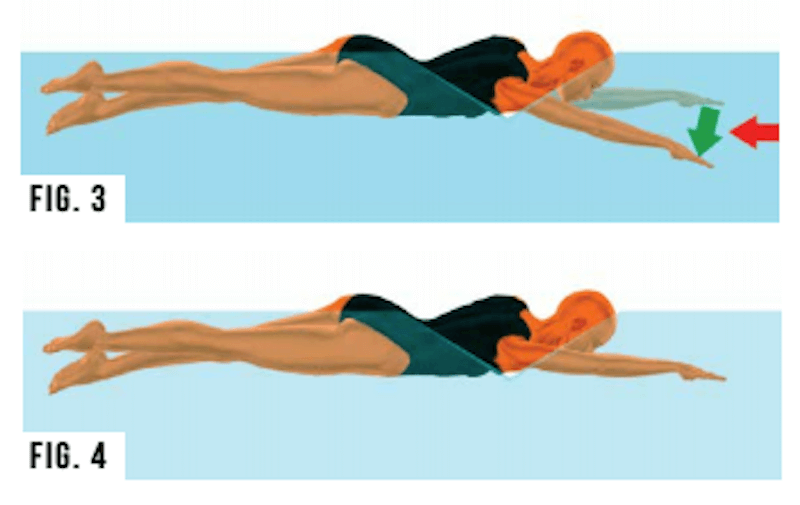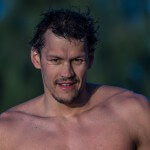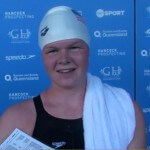Swimming Technique Misconceptions: Hull Length

Swimming Technique Misconceptions: Hull Length
Many people believe that the technique of the fastest swimmers is worth copying, resulting in numerous misconceptions. In reality, even the fastest swimmers have technique limitations, but they offset them with strength and conditioning. The purpose of this series of articles is to address scientifically the technique misconceptions that have become “conventional wisdom,” and to present more effective options.
A common technique misconception is that maintaining the entry arm straight in front of the body on freestyle can increase a swimmer’s body length. Actually, the hull length of a ship (or swimmer’s body) is determined by the length of the body at the surface. While a longer hull has an advantage, a submerged arm does nothing to increase hull length.
More of this article on pages 22 and 23 of the July 2015 Issue of Swimming World Magazine. The article was written by Dr. Rod Havriluk who is a sports scientist and consultant who specializes in swimming technique instruction and analysis. His unique strategies provide rapid improvement while avoiding injury. Learn more at the STR website—swimmingtechnology.com.
Check out the inside Swimming World video:
Not a subscriber? Swimming World Magazine Subscription gives you unlimited access to all online content on SwimmingWorldMagazine.com and access to all of the back issues of Swimming World Magazine dating back to 1960! Purchase your Total Access Subscription TODAY!
JULY TABLE OF CONTENTS:
FEATURES
012 SWIMMING’S “ORPHAN” FINDS HOME IN SERBIA
by Annie Grevers
Russian-born Arkady Vyatchanin has endured quite an interesting journey since capturing the Olympic bronze medal in the 200 backstroke at Beijing in 2008. After a disappointing London Games in 2012 and a series of disagreements with the Russian Swimming Federation, the 31-year-old will start a new chapter in his swimming career by representing Serbia internationally.
016 TAKING IT OUT FAST
by George Block
Part III in a continuing series on saving scholarship swimming focuses on what is being done by the College Swimming Coaches Association and discusses common issues and fund raising. It also suggests ways of what we can do to help solve the problem.
026 SETTING THE STAGE
by Jeff Commings
Swimming’s main stage is reserved for the 2016 Olympic Games, but this summer’s World Championships in Kazan, Russia could show who will be ready to command the spotlight next year in Rio de Janeiro.
031 YOUNG SWIMMERS ON THE RISE
by Annie Grevers
Seventeen-year-olds Becca Mann and Mark Jurek seem to have all the necessary skills to take their swimming to the next level.
034 OPPORTUNITY TO FAIL IN A SAFE ENVIRONMENT
by Michael J. Stott
With the ever-changing expectations and limitations put on today’s swim coach, Swimming World asked some experienced coaches in the United States their thoughts about “tough love” and coaching.
037 HOUSE OF FINA RESTS ON SHIFTING SANDS
by Craig Lord
Swimming governance has reached a watershed. The World Championships will soon unfold in Kazan, Russia against a backdrop of schism in the pool and scandal in world sport.
COACHING
010 LESSONS WITH THE LEGENDS: JIM STEEN
by Michael J. Stott
019 PAVING THE WAY
by Michael J. Stott
Success (or failure) of a taper depends largely upon the previous quality of work. Coaches of three USA Swimming club teams share how they taper their age group and senior swimmers.
022 SWIMMING TECHNIQUE MISCONCEPTIONS: HULL LENGTH
by Rod Havriluk
A common technique misconception is that maintaining the entry arm straight in front of the body on freestyle can increase a swimmer’s body length. Actually, the hull length of a ship (or swimmer’s body) is determined by the length of the body at the surface. While a longer hull has an advantage, a submerged arm does nothing to increase hull length.
041 Q&A WITH COACH TED KNAPP
by Michael J. Stott
042 HOW THEY TRAIN EUGENE GODSOE
by Michael J. Stott
TRAINING
044 DRYSIDE TRAINING: SO YOU WANT MORE POWER?
by J.R. Rosania
JUNIOR SWIMMER
024 GOLDMINDS: G.O.T. TRAINING?
by Wayne Goldsmith
Goal-Oriented Training (G.O.T.) challenges swimmers to achieve specific performance related goals in every training activity. The volume of training is not determined by adherence to a pre-determined training plan, but by the swimmer’s commitment, effort and level of engagement.
COLUMNS
045 UP & COMERS
008 A Voice for the Sport
040 DADS ON DECK
046 Gutter Talk
048 Parting Shot










Hull length alone is simplifying the drag – there is also streamline and frontal area (both are probably more important to drag).
I’d say the bigger challenge with long arm extension is difficulty getting a good catch (weak position for elbows and wrists). It also lowers the stroke rate.
Good insight bro xx
Good hull length is important, but as per your point not the only thing. You can ride your arm if you have a TREMENDOUS kick, but most people do not.
If your shoulders reach forward it will weaken your catch and put you at risk for injury.
Keep your shoulder blades down!
Both statements above and below are good points made. Riding the arm is something not new to swimming and body surfers knew this most likely better at an early stage of understanding the physics of hull dynamics of the human body moving through the water. If they paid attention earlier then simply understanding ship design would have helped. A good stroke coach would be able to point out dynamic body forming factors important to a particular swimmer much easier than reading a book that simply states general thrends.
What is important for the learning coach to understand is first, no two swimmers are the same. Second is that in each millisecond the total mechanics changes.
For example, the legs, even though they belong to the propulsion system, like the arms do, belong the the hull system. The main component, is like it should be understood, is part of the dynamic hull system. Any changes in the dynamic hull system will be reflected by changes in the total drag.
Each body needs to be fine tuned to get the best performance. A formula one racing car is child’s play against the possibilities of an ever changing dynamics of a swimmer. Everything has to do with everything. But if it matters or not is not easy to estimate.
Trade offs between the energy application, preservation and management of expenditure; glide turbulence; propulsion turbulences; power application; and the management of all these system intergrating them together with all the sensory processing at a time the body is developing is an art, based on our science knowledge. Ignoring facts of science might lead inadvertently to a break through on stroke technique, but an artistic approach to those facts would be a much more logical design and more promising future.
Simply said pay attention to the facts, trends and general knowledge, but more important what your swimmer does and try to understand how to lead them to faster performances.
Top swimmers are doing something right and maybe they are doing something you can give to your swimmers.
Ben Garratt
Thank you for stating that no two swimmers are the same! I thought I was the only one who thought that
I thought I was the only one who thought that  what works for one doesn’tnecessarily work for another.
what works for one doesn’tnecessarily work for another.
Best quote I’ve heard in a while was Dr. Gary Hall’s: “Swimming speed is determined by propulsive forces minus drag forces”. It all works together.
Melissa, but we all are swimming in the same water, just not in the same hull. What we make of the difference is what is seen on the stop watch… good luck.
good luck.
Lo hace igual que yo?